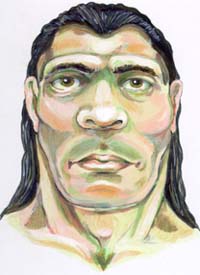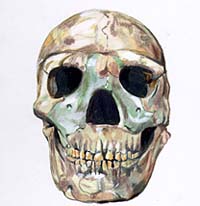|
ANTHROPOLOGISTS
like to imagine a Pygmalion-like experiment that involves releasing
a Neandertal in the New York subway. Groomed, slipped into a specially
tailored Armani suit, and grasping a cell phone instead of a flint,
could he pass as a modern human?
TRUE, the
average New Yorker might not look closely enough to discern the distinctive
Neandertal body hidden beneath the suit--barrel-chested, short-legged,
and strong as an Olympic powerlifter. But even the most indifferent
subway rider couldn't look a Neandertal in the face without a small
shock. Eyes set deep beneath an overhanging brow ridge. A short, receding
forehead. A face that juts forward from the rest of the skull, almost
forming a snout. An enormous nose--wide, long, and protruding, a combination
found in no modern humans. Massive jaws and teeth, particularly those
at the front of the jaw--but no chin.
Since Neandertals were discovered about 150 years
ago, their reputation has undergone more revisions than Richard Nixon's.
Scientists have battled over what Neandertals looked like, how they
lived, and where they belong in our family tree. Today, some of these
once-hot controversies have cooled into agreement. Most anthropologists
concur that if we could look a Neandertal in the eye, we would not be
looking into the face of an ancestor. Reflecting this view, modern humans
(Homo sapiens), who first appeared in Africa about 140,000 years ago,
are now classifed in a different species from the Neandertals (Homo
neanderthalensis), who inhabited Europe, western Asia, and the Middle
East from about 300,000 years ago to 30,000 years ago.
But the field hasn't gone cold. Just as many questions
remain unanswered about the Neandertals and continue to provoke research
and passionate debate. For example, Neandertals loom in our imagination
partly because of their exaggerated facial features. But why did Neandertals
evolve this ugly mug? What function did the bulbous nose, protruding
face, and enormous jaws serve?
next
>>
|


